Every Halloween, the newspapers, magazines, and websites trot out the same old list of the ‘best’ horror films to rent during the scary season. All the lists are haunted by the same films: The Exorcist, Rosemary’s Baby, Scream, Psycho, Night of the Living Dead, the Lugosi Dracula or Boris Karloff Frankenstein, and The Blair Witch Project.
Not that there’s anything wrong with those films. In fact, many are among my favourites of the genre. But wouldn’t it be nice to unearth a list of fright flicks that are not as well known as these top-tier terror films? Movies that may take a bit of shoveling to unbury at your local video store or online retailer?
Here, then, are ten of my favourite lesser-known horror flicks. They will be familiar to hard-core devotees of the genre, but will likely be unknown by the more casual viewer. If you are in the mood for some off-the-beaten-path creepiness, it’s well worth tracking these films down.
1. BLACK SUNDAY
1960; Directed by Mario Bava; Written by Ennio De Concini, Mario Serandrei, and Mario Bava; Starring Barbara Steele.
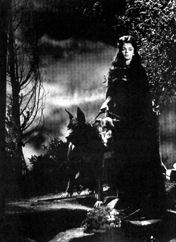 Italian director Mario Bava showed himself to be a master of camera movement, lighting, photography, and mood in this horror classic. The sheer beauty of the camerawork is obvious from the moment the picture starts, with a prologue that shows the execution of two witches, the female witch Katia played by ‘scream queen’ Barbara Steele. Filmed on a soundstage in gorgeous black-and-white, the prologue has a slightly unreal, oddly beautiful look that inhabits the entire film. This prologue also features Black Sunday’s most grisly and memorable image: a spiked mask, called the Mask of Satan (the film’s original title), being gruesomely hammered onto Katia’s face while she is tied to a stake. Years later, Katia is accidentally resurrected and plots to possess the body of her look-alike descendent.
Italian director Mario Bava showed himself to be a master of camera movement, lighting, photography, and mood in this horror classic. The sheer beauty of the camerawork is obvious from the moment the picture starts, with a prologue that shows the execution of two witches, the female witch Katia played by ‘scream queen’ Barbara Steele. Filmed on a soundstage in gorgeous black-and-white, the prologue has a slightly unreal, oddly beautiful look that inhabits the entire film. This prologue also features Black Sunday’s most grisly and memorable image: a spiked mask, called the Mask of Satan (the film’s original title), being gruesomely hammered onto Katia’s face while she is tied to a stake. Years later, Katia is accidentally resurrected and plots to possess the body of her look-alike descendent. The screenplay of Black Sunday seems confused as to whether Katia is a resurrected witch or a vampire, but as with all Bava’s films the plot matters only as a means to show startling images and develop a tangible haunted atmosphere. Shot after beautifully composed shot lingers in the memory, and the sight of the undead witch Katia with black pits in her face from the spiked mask is one of the iconic images of horror cinema. With a face that skirts the edge of beauty but seems not quite right, Barbara Steele delivers a wonderful central performance, and went on to become one of the great actresses of European horror films. Soaked with an atmosphere reminiscent of the old Universal Studios horror films from the ’30s and ’40s, Black Sunday is one of the most beautifully shot movies in the entire horror genre.
Black Sunday is currently available in a wonderful DVD edition that brings the film to life with stunning clarity.
Also Recommended: Bava’s films are so uneven, that it’s hard to wholeheartedly recommend another of his movies. The anthology horror film Black Sabbath is reportedly very good, though unseen by me. Planet of the Vampires, a cheap science-fiction horror flick, is mostly silly but has a few stylishly memorable sequences, and amazingly appears to be one inspiration behind Ridley Scott’s Alien. Both these films are available on DVD.
2. THE BROOD
1979; Written and Directed by David Cronenberg; Starring Art Hindle, Oliver Reed, and Samantha Eggar.
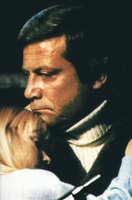 The horror films of Canadian writer/director David Cronenberg often seem to revolve around the human body mutating and turning against us in some way. The Brood, his third horror film and the first excellent movie in his resume, is no exception. The story involves Frank Carveth (Art Hindle), whose wife (Samantha Eggar) is undergoing an innovative psychotherapy called ‘psychoplasmics’ through the clinic of Dr. Hal Raglan (Oliver Reed). In psychoplasmics, the patient is encouraged to manifest rage physically, through their bodies. Frank is skeptical about his wife’s therapy, a skepticism that turns to horror when mysterious dwarf-like figures begin gorily murdering people close to him. It’s up to Frank to find out if psychoplasmics and the murders are related, and protect his young daughter.
The horror films of Canadian writer/director David Cronenberg often seem to revolve around the human body mutating and turning against us in some way. The Brood, his third horror film and the first excellent movie in his resume, is no exception. The story involves Frank Carveth (Art Hindle), whose wife (Samantha Eggar) is undergoing an innovative psychotherapy called ‘psychoplasmics’ through the clinic of Dr. Hal Raglan (Oliver Reed). In psychoplasmics, the patient is encouraged to manifest rage physically, through their bodies. Frank is skeptical about his wife’s therapy, a skepticism that turns to horror when mysterious dwarf-like figures begin gorily murdering people close to him. It’s up to Frank to find out if psychoplasmics and the murders are related, and protect his young daughter. What makes The Brood so interesting is that it works on two levels. First, it is a dynamite horror flick, complete with suspense, shocks, and dabs of gore. But secondly, it is an intriguing psychological meditation on the horror of bodily mutation and the forces that threaten one’s family. Cronenberg is one of the most intelligent filmmakers that has ever worked in the horror genre, and The Brood has an underlying depth that rewards multiple viewings. Be warned, though, that there is some repellent imagery in this film, with the final sequence especially unsettling for queasy viewers. A consistently challenging director, David Cronenberg certainly knows how to stimulate your mind and get under your skin at the same time.
The Brood is available on DVD in a bare-bones edition that features a crisp widescreen transfer.
Also Recommended: Of Cronenberg’s other films in the genre, the best are his romantic-tragic remake of The Fly, the surreally bizarre science-fiction horror Videodrome, and his compelling adaptation of Stephen King’s The Dead Zone, which features a great central performance by Christopher Walken. All these films are available on DVD.
3. CURSE OF FRANKENSTEIN / HORROR OF DRACULA
1957; Directed by Terence Fisher; Written by Jimmy Sangster; Starring Peter Cushing, Christopher Lee.
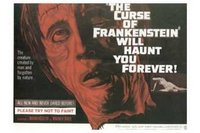 I’ve cheated a bit with this selection, by picking a double bill. However, these two films are so essential to the history of the horror genre, and work so well together as a Halloween double feature, that I couldn’t resist. Produced by England’s Hammer Films, Curse of Frankenstein and Horror of Dracula have been rightly described as epoch-making films that completely revitalized the horror genre when it was in a postwar decline, and influenced several subsequent generations of films and filmmakers. The shockwaves that these movies caused upon initial release are still being felt in horror cinema today.
I’ve cheated a bit with this selection, by picking a double bill. However, these two films are so essential to the history of the horror genre, and work so well together as a Halloween double feature, that I couldn’t resist. Produced by England’s Hammer Films, Curse of Frankenstein and Horror of Dracula have been rightly described as epoch-making films that completely revitalized the horror genre when it was in a postwar decline, and influenced several subsequent generations of films and filmmakers. The shockwaves that these movies caused upon initial release are still being felt in horror cinema today.Curse is a reinterpretation of the Frankenstein story that discards almost all elements of the Universal Frankenstein movies, which up until this point were the definitive versions of this gothic horror tale. The emphasis of the film is squarely on Baron Frankenstein, played to classical perfection by genre great Peter Cushing. In this version, the Baron is not merely a misguided scientist. He is a brilliant, intense intellectual whose pursuit of knowledge is so single-minded that he is not above murder to achieve his aims. Christopher Lee, with whom Peter Cushing would co-star in many enjoyable horror movies, stars as the Creature, stitched together out of body parts stolen from cadavers and less-than-willing donors. The Creature features grotesque make-up by Hammer’s regular makeup artist Phil Leakey, who was forbidden by copyright to create anything resembling the Frankenstein Monster from the Universal films. The scene where the Creature awakes and removes the bandages from its face, revealing its distorted features for the first time still packs a punch today. And Lee manages to infuse the Creature with a sad, pathetic quality that arouses audience sympathies.
Though tame by today’s standards, Curse of Frankenstein was greeted with cries of revulsion from the critical establishment when it was initially released in the late 50s. It was one of the first films to show its horrors instead of discreetly suggesting them, with Frankenstein coolly examining severed body parts, and a bloody sequence involving the Creature being blasted in the head with a shotgun. Audiences, however, lined up around the block, and the legendary gothic horror movies of Hammer Films were launched, changing the genre forever.
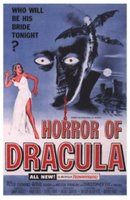 The success of this film led to Hammer remaking another iconic horror film. Using the same creative team of director Terence Fisher and writer Jimmy Sangster, and reteaming stars Christopher Lee and Peter Cushing, Hammer Films produced Horror of Dracula, a very loose adaptation of Bram Stoker’s famous novel. Christopher Lee, with his mix of regal charm and snarling animalism, provides arguably the best interpretation of the vampire count, in spite of very little dialogue. However, performance-wise the film belongs to Peter Cushing who brings charm, steely nerves, quick wit, compassion, and swashbuckling energy to the role of vampire hunter Van Helsing. Like Curse, Horror of Dracula is beautifully shot in vivid, blood-red Technicolour.
The success of this film led to Hammer remaking another iconic horror film. Using the same creative team of director Terence Fisher and writer Jimmy Sangster, and reteaming stars Christopher Lee and Peter Cushing, Hammer Films produced Horror of Dracula, a very loose adaptation of Bram Stoker’s famous novel. Christopher Lee, with his mix of regal charm and snarling animalism, provides arguably the best interpretation of the vampire count, in spite of very little dialogue. However, performance-wise the film belongs to Peter Cushing who brings charm, steely nerves, quick wit, compassion, and swashbuckling energy to the role of vampire hunter Van Helsing. Like Curse, Horror of Dracula is beautifully shot in vivid, blood-red Technicolour. Again, many respectable film critics were horrified, especially at the film’s explicit connection between sexuality and vampirism. And once more, the film was a huge international hit, spurring Hammer Films to remake more classic horrors, beginning with The Mummy. Today, these two films have long since lost their power to shock, but they remain highly entertaining, their professional polish, intelligent scripts, wonderful gothic atmosphere, and sharp wit overcoming their low budget origins. Curse of Frankenstein and Horror of Dracula make a marvelous, fun Halloween double feature, and allow you to revisit a lost era of studio filmmaking and a time when the flagging horror genre lurched once again to renewed life.
Both of these Hammer horror films are available in gorgeous widescreen versions on DVD that are the best these films have ever looked on home video.
Also Recommended: Other worthwhile Hammer gothic horrors are numerous, including the direct sequels to the first Dracula and Frankenstein flicks, Dracula, Prince of Darkness and Revenge of Frankenstein. The Dracula series deteriorated in quality, though Scars of Dracula is worthwhile. In contrast, the Frankenstein series offered several intriguing films, the best of which are Frankenstein Created Woman and Frankenstein Must be Destroyed. Other notable Hammer horror flicks are Brides of Dracula, The Reptile, Plague of the Zombies, Kiss of the Vampire, Hands of the Ripper, The Curse of the Werewolf, The Mummy, The Devil Rides Out and Captain Kronos, Vampire Hunter. All of these films are available on DVD or video, except for (sadly), Hands of the Ripper, which is out of print though sometimes available on EBay. Also of interest is a good documentary on Hammer Studios, called Flesh and Blood, which is on video and DVD. Warner Home Video also has The Hammer Horror Series a 2-disc DVD set that contains eight Hammer horror and thriller flicks; it is a must-have for all Hammer fans.
4. NIGHT OF THE DEMON
1957; Directed by Jacques Tourneur; Written by Charles Bennett and Hal E. Chester, based on the story "Casting the Runes" by M.R. James; Starring Dana Andrews, Peggy Cummins, and Niall MacGinnis.
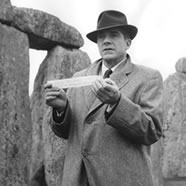 The legacy of producer Val Lewton (see Isle of the Dead, below) was not only a collection of superb psychological horror films, but also a stable of filmmakers who perfected their craft on his films. French director Jacques Tourneur was one of them. Having directed the classics Cat People, I Walked with a Zombie, The Curse of the Cat People, and The Leopard Man for Lewton, Tourneur carried on the tradition of subtle psychological horror with the wonderful Night of the Demon.
The legacy of producer Val Lewton (see Isle of the Dead, below) was not only a collection of superb psychological horror films, but also a stable of filmmakers who perfected their craft on his films. French director Jacques Tourneur was one of them. Having directed the classics Cat People, I Walked with a Zombie, The Curse of the Cat People, and The Leopard Man for Lewton, Tourneur carried on the tradition of subtle psychological horror with the wonderful Night of the Demon. Based on the short story Casting the Runes by the great ghost story writer M.R. James, Night of the Demon involves a debunker of the supernatural, psychologist Dr. Holden (Dana Andrews), investigating the death of a researcher in England who was working on an expose of occultist Karswell (Niall MacGinnis). Holden’s skepticism is put to the test as Karswell passes him a scrap of parchment with runic symbols that marks the holder with death at the hands of a demon, and his investigation slowly convinces him that perhaps Karswell can indeed wield dark forces.
The film plays on the Lewtonian question of is the supernatural involved or is it all in the mind? The balance is tipped somewhat in the favour of the supernatural explanation with the inclusion of a demonic monster in the opening sequence, but the creature is creepy and memorable, and its presence hangs over the rest of the film like a shroud. Tourneur expertly builds tension and fear throughout the film, with a wonderful use of darkness and shadows. A sequence set in a darkened wood with Holden pursued by a ball of supernatural light after smoking footprints appear in the earth is particularly spooky and memorable. The climax of the film, though marred by some cheap effects, still brings the story to a satisfyingly chilling conclusion. With a terrific performance by Niall MacGinnis that manages to be sinister, humourous, and humanistic, Night of the Demon is one of the all-time great movies of the supernatural.
A DVD edition of this film features the original British cut, Night of the Demon, together with Curse of the Demon, which is the truncated American version. Needless to say, Night is the preferable version. The clarity of this black-and-white film on this DVD is very impressive.
5. THE FOG
1980; Directed by John Carpenter; Written by John Carpenter and Debra Hill; Starring Tom Atkins, Adrienne Barbeau, and Jamie Lee Curtis.
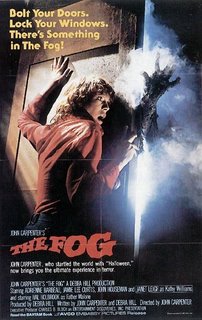 The Fog, John Carpenter’s follow-up to his wildly successful Halloween, has never garnered the popularity of his first horror film. Which is a shame, because The Fog is a well-made, eerie mood piece punctuated with several memorable shocks. Adrienne Barbeau, Halloween alumnus Jamie Lee Curtis, and Tom Atkins star as residents of small seaside town Antonio Bay, which is preparing to celebrate its 100th birthday. Little do they know that the founding of the town rests on a dark secret, one that will rise up from the coastal waters and return to take revenge, enshrouded in — the fog.
The Fog, John Carpenter’s follow-up to his wildly successful Halloween, has never garnered the popularity of his first horror film. Which is a shame, because The Fog is a well-made, eerie mood piece punctuated with several memorable shocks. Adrienne Barbeau, Halloween alumnus Jamie Lee Curtis, and Tom Atkins star as residents of small seaside town Antonio Bay, which is preparing to celebrate its 100th birthday. Little do they know that the founding of the town rests on a dark secret, one that will rise up from the coastal waters and return to take revenge, enshrouded in — the fog.Essentially a classic ghost story with added violence and shocks, The Fog is reminiscent of a spooky story told around a campfire. In fact, the film opens with a prologue in which Mr. Machen (John Houseman; the character named after the great writer of supernatural fiction Arthur Machen) tells a ghost story to a troop of boy scouts huddled around a campfire on a darkened beach.
Carpenter tells the story well, building suspense and fear. As with all of his films, he uses the widescreen movie frame to maximum effect, often placing key information at opposite sides of the screen. This is one reason why viewing a widescreen version of The Fog is essential; the pan-and-scan version removes so much information as to be a complete waste of time. Carpenter also provides the film’s wonderful electronic music score, which serves to heighten the suspense and sense of dread anticipation. A gem of a horror movie, The Fog is one of the best ghost stories ever filmed.
Luckily for current and future fans of the film, The Fog is available in a terrific special edition DVD. A dire remake of this film was released in 2005, and should be avoided like the plague.
Also Recommended: John Carpenter has directed two other horror films that are essential viewing--the classic and influential Halloween and the groundbreaking science-fiction horror of The Thing. His other genre films are a bit of a mixed bag, though both Prince of Darkness and In the Mouth of Madness have several imaginative touches.
6. ISLE OF THE DEAD
1942; Directed by Mark Robson; Written by Josef Mischel and Ardel Wray; Produced by Val Lewton; Starring Boris Karloff.
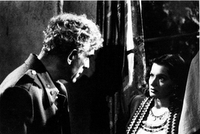 A Russian immigrant, film producer Val Lewton was given carte blanche by RKO Studios to assemble his own creative team and make a series of horror movies with little interference. The only catch was that he had to use the studio’s market-tested titles. The result was some of the most intelligent psychological horror movies ever made hiding under lurid titles like I Walked with a Zombie and Cat People.
A Russian immigrant, film producer Val Lewton was given carte blanche by RKO Studios to assemble his own creative team and make a series of horror movies with little interference. The only catch was that he had to use the studio’s market-tested titles. The result was some of the most intelligent psychological horror movies ever made hiding under lurid titles like I Walked with a Zombie and Cat People. Isle of the Dead is typical of the style of the Lewton films, and features one scene that remains frightening to this day. Boris Karloff plays a Greek army officer who is trapped in a house on a small island while the plague ravages the country. The officer, marooned in the house with a motley crew of people, is haunted by peasant superstitions regarding a vampire-like creature. Is a supernatural creature stalking the island? Like most of the Lewton films, this question is never satisfactorily closed.
Though very little happens in most of the film, an atmosphere of fear and dread pervades the movie. A scene in a crypt, simply but effectively shot with a brilliant use of sound, has the power to send serious chills down the spine. Aside from the intelligence of the stories, this is the great achievement of the Lewton films: though made in the 1940s, they have the power to chill today. Isle of the Dead is a dark and creepy little film that lingers in the half-light of memory.
Also Recommended: If you like Isle of the Dead, then the other Lewton-produced horror films are a must--Cat People (avoid the 1982 remake with Nastassia Kinski), The Seventh Victim, The Leopard Man, I Walked with a Zombie, The Curse of the Cat People, and The Body Snatcher (which reteamed horror icons Boris Karloff and Bela Lugosi). All the Lewton horror series is available on DVD, some separately as double-feature discs, and together in a DVD box set. No horror fan’s film collection should be without this set.
7. SESSION 9
2001; Directed by Brad Anderson; Written by Brad Anderson and Stephen Gevedon; Starring David Caruso and Peter Mullen.
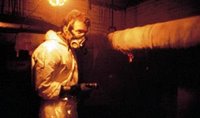 You know what they say: location, location, location. Session 9 has one of the truly great locations of any horror film: the abandoned Danvers Mental Hospital outside Boston, a sprawling, decaying, manor house dating from around 1880 that operated as an asylum until about the mid-1980s. The location is real, though the story of Session 9 is not. It concerns a hazardous materials removal crew headed by Gordon Fleming (Peter Mullan) hired to remove the asbestos from the Danvers Hospital. Wearing protective gear, the crew goes into the bowels of the deserted, crumbling, and foreboding hospital to do their job.
You know what they say: location, location, location. Session 9 has one of the truly great locations of any horror film: the abandoned Danvers Mental Hospital outside Boston, a sprawling, decaying, manor house dating from around 1880 that operated as an asylum until about the mid-1980s. The location is real, though the story of Session 9 is not. It concerns a hazardous materials removal crew headed by Gordon Fleming (Peter Mullan) hired to remove the asbestos from the Danvers Hospital. Wearing protective gear, the crew goes into the bowels of the deserted, crumbling, and foreboding hospital to do their job.After several creepy scenes of the workers wandering in the building’s grim labyrinth, Mike (Stephen Gevedon) finds a set of audiotapes containing sessions in which a therapist is treating a patient with multiple personalities using ‘recovered memory’ therapy. To add to the creepiness, these tapes are based on actual case files and tapes that the filmmakers found at the location. As Mike becomes obsessed with these tapes, the other workers start to slowly become influenced by the oppressive building, and one of them apparently descends into madness. But which one, and why?
Aside from the fantastic location, the strength of Session 9 is its oppressive, disturbing atmosphere, and the parallel stories of the workers and the audiotapes that may or may not connect (I refuse to give away any of the film’s secrets, but suffice it to say that the ending leaves much food for thought and bad dreams). Filmed using a digital camera that adds effectively to the film’s verisimilitude, Session 9 is one of the few modern horror films that manages to be genuinely scary. And it accomplishes this with an almost complete lack of special effects and explicit violence. Unfortunately ignored during its limited initial release, the creepy and chilling Session 9 is ripe for rediscovery.
Also Recommended: Other films featuring great horror houses include The Haunting (the 1960s original, not the recent CGI fiasco); The Legend of Hell House, a good, though far from great, adaptation of a very scary Richard Matheson novel; and The Uninvited with Ray Milland, a classic ghost story. Director Brad Anderson’s grim psychological drama The Machinist, while not really a horror film, is also of interest. It features a Twilight Zone-ish wierd story that is well-told, and an amazing central performance by Christian Bale.
8. THE STEPFATHER
1987; Directed by Joseph Ruben; Written by Donald Westlake; Starring Terry O•Quinn, Jill Schoelen, and Shelley Hack.
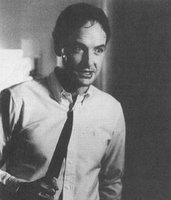 It’s arguably one of the greatest performances in any psychological horror film. In The Stepfather, Terry O’Quinn (known these days for the hit TV show Lost) stars as Jerry Blake, a seemingly normal, staid, down-to-earth guy who is dating Susan (Shelley Hack) and trying to be a good stepfather to her daughter Stephanie (Jill Schoelen). Jerry, however, is not all he seems, as his nice façade hides a psychotic personality that obsessively searches for the perfect all-American family, and when that family doesn’t meet his Ward Cleaver standards...
It’s arguably one of the greatest performances in any psychological horror film. In The Stepfather, Terry O’Quinn (known these days for the hit TV show Lost) stars as Jerry Blake, a seemingly normal, staid, down-to-earth guy who is dating Susan (Shelley Hack) and trying to be a good stepfather to her daughter Stephanie (Jill Schoelen). Jerry, however, is not all he seems, as his nice façade hides a psychotic personality that obsessively searches for the perfect all-American family, and when that family doesn’t meet his Ward Cleaver standards...O’Quinn is simply wonderful in the lead role, believably creating Jerry’s too-shiny surface and the darkness lurking beneath. But Jill Schoelen is also superb as a realistically portrayed teenage girl who, with probing intelligence and spunk, digs for the truth behind her ‘perfect’ stepfather. The scene where she, unknown by Jerry, observes him talking to himself in the basement of their house is brilliant and scary. Well-written by mystery writer Donald Westlake, the film builds effectively, slowly drawing the suspense tighter, until it reaches an unbearable level and explodes in a predictable but still scary climax. The Stepfather is a nifty little psycho-horror film, and well worth searching out. Unfortunately, as of writing, the film is unavailable on DVD, though some video stores may carry a VHS copy.
9. SUSPIRIA
1977; Directed by Dario Argento; Written by Dario Argento and Daria Nicolodi; Starring Jessica Harper.
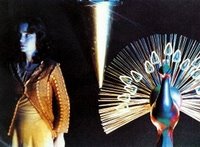 A bizarre dark fairy story, Suspiria’s story doesn’t unfold so much as crawl around in your subconscious for a little while. What little plot there is concerns American Suzy Bannion (Jessica Harper) arriving in Europe to begin studying at a school of ballet. Taking a taxi to the school through a black and rainy night that seems to resonate with weirdness, Suzy witnesses a girl fleeing the rather ominous school building. Later, this girl is gorily murdered by a disembodied arm (we never see the rest of the body of the assailant). This is only the beginning of a series of strange events, including maggots raining from the ceiling and more bizarre murders, that lead to a supernatural revelation about the school and those who run it.
A bizarre dark fairy story, Suspiria’s story doesn’t unfold so much as crawl around in your subconscious for a little while. What little plot there is concerns American Suzy Bannion (Jessica Harper) arriving in Europe to begin studying at a school of ballet. Taking a taxi to the school through a black and rainy night that seems to resonate with weirdness, Suzy witnesses a girl fleeing the rather ominous school building. Later, this girl is gorily murdered by a disembodied arm (we never see the rest of the body of the assailant). This is only the beginning of a series of strange events, including maggots raining from the ceiling and more bizarre murders, that lead to a supernatural revelation about the school and those who run it.Suspiria doesn’t make a lot of logical sense, it has to be said. But stylish Italian director Argento never intended it to make any sense, except on the level of a bad dream. The film is brilliantly designed and shot to resemble a very (very) grim fairy tale, with the main characters akin to children in a story from the Brothers Grimm. This point is reinforced when you notice that all the door handles are made to be higher than normal, so the characters have to reach up for them to open doors, just like children.
This film is very gory, so be warned, but it is also very beautiful. Shot using an old three-strip Technicolour process, the colours of Suspiria are absolutely gorgeous. Apparently, this was the last time that the three-strip camera was used; it was scrapped after filming wrapped up.
Dario Argento has been called the ‘Italian Hitchcock’ for his stylish murder-mystery-thrillers like The Bird with the Crystal Plumage, Deep Red, and Cat O’ Nine Tails. But even those films really have more in common with the horror genre than with mysteries due to their sudden shocks and explicit violence. Suspiria was his first film to completely abandon the mystery genre and rely solely on the supernatural.
Argento has a knack for some stunning camerawork, but often his films leave a lot to be desired plotwise. Suspiria is probably his masterpiece as the story and screenplay mesh perfectly with the direction to achieve the illogic and scariness of a particularly nasty and strange nightmare.
Suspiria is available in a terrific special edition DVD that showcases the stunning colour of the film and preserves the carefully composed shots in the original widescreen.
Also Recommended: Argento’s other supernatural-themed films are Phenomena and Inferno, but both are relatively inaccessible to casual viewers. If his style intrigues you, check out Deep Red, probably the most stylish of his mystery thrillers, and the one most closely tied to the horror genre.
10. THE WICKER MAN
1973; Directed by Robin Hardy; Written by Anthony Schaeffer; Starring Edward Woodward and Christopher Lee.
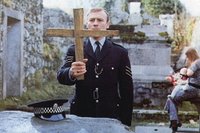 Many of its fans argue about its categorization as a horror film, but The Wicker Man has enough horrific and psychological suspense elements to merit the label. The film tells the unsettling story of prudish police sergeant Neil Howie (Edward Woodward), whose beat is northern Scotland and the offshore islands, investigating the disappearance of a young girl on the remote island of Summerisle. Finding little complicity with his investigation, he observes primitive religious and sexual rites, and realizes that the island is a community of pagans, with the enigmatic Lord Summerisle (Christopher Lee) at its head. He finds evidence that the island people are preparing an elaborate pagan rite, involving the wicker man of the title, to bring fertility to the land again, a rite that may involve human sacrifice...
Many of its fans argue about its categorization as a horror film, but The Wicker Man has enough horrific and psychological suspense elements to merit the label. The film tells the unsettling story of prudish police sergeant Neil Howie (Edward Woodward), whose beat is northern Scotland and the offshore islands, investigating the disappearance of a young girl on the remote island of Summerisle. Finding little complicity with his investigation, he observes primitive religious and sexual rites, and realizes that the island is a community of pagans, with the enigmatic Lord Summerisle (Christopher Lee) at its head. He finds evidence that the island people are preparing an elaborate pagan rite, involving the wicker man of the title, to bring fertility to the land again, a rite that may involve human sacrifice...Wonderfully written, filmed, and acted, The Wicker Man has been described as the “Citizen Kane of horror films,” and as a genre piece that also offers a memorable story with intelligent social commentary it towers above most other horror movies. Though it contains few explicit shocks, the film effectively builds a sense of mounting unease, leading to a shattering climax. And as a statement about the role of religion in society, it leaves much to ponder after the final credits roll.
The Wicker Man is available on DVD as a single-disc edition and in a box set that contains a longer uncut version. A remake of the film, directed by Neil Labute and starring Nicolas Cage, was released in 2006. While not the disaster many have claimed it to be, it is far inferior to the classic original. Accept no substitutes.

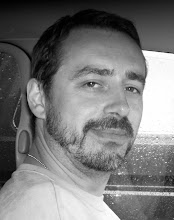

2 comments:
While I can agree with most of your choices for this list of horror films, I cannot endorse your choice of Session 9 (I'm not too thrilled with Suspira or The Stepfather, either). Session 9 was a tired, poorly paced film, with hideous plot twists. The dialogue was dreadful. I'll bet David Caruso denies ever having made this thing.
Instead of Session 9, let me point you in the direction of either "MAY" or "AUDITION". Both films are unique and psychologically disturbing.
Thanks for your comments. "May" and "Audition" are on my to-see list. As is "The Woods", "May" director Lucky McKee's recent horror film, which is apparently Argento-ish in parts. I'm not too thrilled about seeing "Audition", to be frank, as the clips I've seen of Miike's work haven't grabbed me and I've long past the point of digging explicit gore. But I'll give it a shot.
And I stand by my inclusion of "Session 9." It, more than any other recent film I can think of, captures Lewtonesque atmosphere and psychological fear. I strongly disagree with you about this excellent little film.
But disagreement is what makes discussing movies interesting, right?
Post a Comment